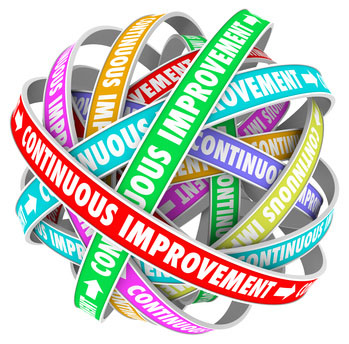 No, this post isn’t about weight loss, cigarette smoking or exercise. It’s about “continuous improvement” from a corporate point of view. But they all have something in common, the need to create a habit; either a habit to promote a positive or a habit to replace a negative. The following discusses an approach for turning continuous improvement into a habit.
No, this post isn’t about weight loss, cigarette smoking or exercise. It’s about “continuous improvement” from a corporate point of view. But they all have something in common, the need to create a habit; either a habit to promote a positive or a habit to replace a negative. The following discusses an approach for turning continuous improvement into a habit.
Matt Cutts of Google gave an interesting TED talk titled “Trying something new for 30 days.” His point was that you can do just about anything for 30 days. If you like the outcome, after 30 days, you have practiced it enough to begin forming a habit. A similar concept, “21 Days to a New Habit,” has been reinforced in other writings. There is no magic in 21 or 30 days. The point is to drive an initiative forward, in a repetitive way, so that it becomes habitual.
The science behind a habit is pretty simple. The act requires the synapses in your brain to connect for the purpose of performing the act. The first time is learning. The following repetitions are exercising that synapse set, in essence wearing in that path to make it second nature. Muscle memory is another example of this process, where repetition reinforces an action making it second nature. The cleaner and more repetitive the act, the stronger the reinforcement and the easier it is to develop the habit.
Clearly, repetition should be used to reinforce corporate goals. The challenge is to clearly define corporate goals, and make them measurable. If you are a fan of Six Sigma, the concept of DMAIC (define, measure, analyze, improve, control) will deliver the process toward improvement. But this doesn’t address the concept of repetition to form a habit, thus making it continuous.
The key to the attainment of corporate goals as a continuous process is to make them a habit. This begins with a clear definition, and then clear delivery in a way that forms and reinforces the habit. The clearer the act, the easier to form a habit. Habits are simple. But habits can also be counterproductive. The process of repetition has its downsides. Repetition also drives desensitization and carelessness. If continuous improvement relies on hours of manual processes − data collection and analysis say on a weekly basis − you are more likely to be driving fatigue and errors into the process due to desensitization and manual errors, not to mention the impacts on job satisfaction. The process of continuous improvement will rely on automated metrics, followed by the habit of interpretation. That is the key to success.
Corporate dashboards are a good solution. They should contain the key performance metrics that will reinforce corporate goals. But dashboards are not always the best method for data transfer. First, they may only be available on an Intranet, limiting their accessibility. Second, dashboards may not be available to all layers of an organization. Third, dashboards may not be available on all platforms (mobile devices). Fourth, dashboards require the user to be proactive. Unless they are tied to an alarm clock, out of sight and out of mind will be an issue. Finally, dashboards may be costly and overkill for the continuous improvement you are seeking.
Automated report generation is a lower cost alternative that will likely drive better results. A report generator can easily collect and summarize the information required to drive continuous improvement, and it will deliver the information to all involved in the simplest ways possible. That might be a file automatically delivered to a directory, or a PDF attachment in an email. Reports can also be posted to a Web portal, acting as your KPI (key performance indicator) dashboard. To drive the habit of continuous improvement, generate the report and deliver it at the same time every day, week, month, etc. Require review of the report at specific times and require comments on the report by the individuals involved. Comments will drive both an interpretation of the results, and translate an understanding of the process by the broader audience. Save copies of past reports for archival purposes and create “reports of reports” to visualize KPIs over time, shifts, batches, or whatever defines your period.
A report generator has the ability to attach to any level of your automation architecture. With real-time connectors, a report generator can connect directly to the sensors or PLCs in your process. This may be valuable for acquiring energy readings, totalizing flows, or collecting run-time hours. A report generator has the ability to do a variety of sophisticated calculations to generate the basis of continuous improvement metrics. Connected to an HMI/SCADA and/or your historian, the report generator has access to your operator console information and alarm logs, and can perform even more sophisticated calculations based on batch information or internal historian analytics. With the addition of business interfaces (relational database drivers, ODBC, OLE-DB), the report generator can now deliver KPI information across batches, including material use, scrap, quality, production efficiency, on-time delivery and the like. But regardless of the level of connection or the depth of analysis, the one key to driving continuous improvement remains simple – making continuous improvement a habit. The automated generation of reports and the automated delivery of reports can be essential to creating the habit of continuous improvement at all levels of your organization.
About the Author

